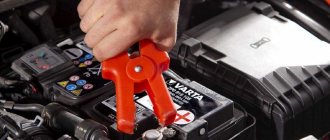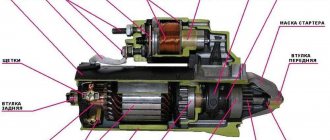The battery is an important component of any modern car. With its help, the engine starts, plus you can turn on different consumers without starting the engine. Thus, the power comes not from the generator, but from the battery.
But over time, the battery capacity may decrease. And at some point, when you turn the key in the ignition, nothing happens. Yes, car service specialists will say that the battery has reached its end, its service life has expired, and it is better to buy a new one. And they will probably tell you where and which one to buy.
But you shouldn't make hasty conclusions. A procedure such as CTC often allows you to resuscitate the battery. This is not a 100% guarantee of returning to full functionality, but a great way to save on buying a new battery. It's at least worth a try.
Why does the charge drop?
All batteries have a certain capacity, stated in Ah. In passenger cars, batteries of 60-80 Ah are most often found. That is, at 60 Ah, the device can produce a current of 1 Ampere for 60 hours. But this is in theory.
In practice, everything is different. As soon as the engine starts, the charge drops significantly. But it is compensated by the operation of the generator. Not all drivers drive a lot and often, and therefore the generator simply does not have time to replenish the entire charge. It has been proven that in most cases, cars are operated with constant undercharging.
Capacity can decrease under the influence of various factors:
- poor fastening, mechanical damage;
- electrical problems;
- violation of the integrity of electrical wiring;
- sulfation processes;
- driving around the city on short trips;
- low ambient temperature, etc.
Since most drivers drive in such conditions, it is imperative to periodically check the condition and charge of the battery.
Concept of CTC
Now we should understand in more detail the control and training cycle for batteries, since not everyone understands what it is and why it is carried out.
The batteries used in cars are lead-acid. They differ from each other in design features, additives used, and consistency of the electrolyte used. Therefore, there are AGM batteries, gel batteries, calcium batteries, etc.
The battery life is usually indicated by the manufacturer on the device body. However, you can often see figures within 5-10 years. This period seems quite acceptable, since the prospect of changing batteries every 7-8 years is encouraging. But the stated deadlines rarely coincide with the real ones. This is due to difficult working conditions, driving with constant undercharging. This affects cars used in the city and traveling short distances. Add to this low temperatures and neglect.
To minimize the cost of purchasing a new battery, you should do everything possible to extend the life of your existing battery. For this purpose, such a procedure as the CTC is provided.
A control-training cycle is a procedure that is carried out to restore discharged and old batteries. Its meaning is to completely discharge and then charge the device.
CTC allows you to partially restore characteristics and improve battery performance. You should not count on the same 100% efficiency as it was when you purchased it. But the battery will definitely serve you for an additional 2-3 years.
The recommended frequency of CTC is 2 times a year.
Why train your battery?
The battery needs to be regularly diagnosed: check its external condition, the voltage it produces, and the electrolyte level in it.
Typically, such a check is combined with a seasonal technical inspection. If the battery does not charge well and runs out quickly, this is the first sign that it is time to conduct a control and training cycle. At home, battery CTC can be carried out in any room where there is an exhaust hood. The control and training cycle of acid batteries can be done in the garage, but always with the battery removed and disconnected from all consumers. We recommend: Why the red indicator on the battery is on. Carrying out the CTC of batteries can also be entrusted to specialists. However, this procedure is not at all difficult, and it is quite possible to do it yourself. For this you will need:
- Charger;
- two wires;
- voltmeter;
- rheostat or light bulb of suitable power;
- a clock to keep track of time.
It must be remembered that when charging batteries, hydrogen is released, so the room in which work with the battery is carried out must be well ventilated.
You should refrain from smoking and using open fire. Battery electrolyte is a strong acid, and when working with it, all necessary precautions must be taken to protect the skin, eyes and respiratory system.
Why do you need training?
Not everyone fully understands why such training is carried out on an old or dead car battery.
There are several main reasons:
- desire to postpone the purchase of a new expensive battery;
- increasing the service life of the used battery;
- resuscitation of a battery that was forgotten and found after a long time;
- restoring the characteristics of a battery that has been in use for a long time.
In some cases, when the battery has been lying in the garage for a couple of years or they simply forgot to remove it from the car, leaving it for long-term storage without the terminals removed, it is possible to restore the battery, which seems already condemned to disposal.
Correctly carried out training of an old car battery, when charging and discharging, allows the car owner to save money. Plus, the battery will somewhat restore its characteristics, and therefore the engine will start easier even in severe frosts.
Sequence of the CTC procedure
Many people carry out CTC of old batteries at home and successfully complete the tasks.
To perform this procedure, you will need to prepare:
- Charger;
- hydrometer;
- load of the required size;
- multimeter
Self-charging your own car battery using the CTC method quite often gives a positive result. But for this it is important to strictly follow the instructions and adhere to the given sequence.
To complete the training cycle, that is, charge and discharge worn-out batteries, you should learn how to use a multimeter.
The procedure itself includes 3 stages:
- pre-charge;
- control digit;
- charge.
It is important to perform each stage correctly. If during normal maintenance you only need to discharge the battery, then with CTC of the battery you need to know to what voltage to do this and when to start the reverse action.
Preliminary calculations are carried out for a specific battery to determine the exact load.
Preliminary stage
If you delve into the essence and study all the details, then the scheme for carrying out the CTC of a car battery will not seem so complicated. Therefore, many successfully do it with their own hands.
If you have a good quality factory charger, no problems will arise. Just connect the battery to the charger and wait for the process to complete.
The voltage up to which CTC will need to be carried out depends on the specific battery and the conditions of the cycle. Therefore, study its technical characteristics.
The charge is carried out according to the density of the electrolyte located inside and according to the voltage. When precharging the battery, focus on the following values:
- A voltage of 12.72 V corresponds to a density of 1.28 and indicates a 100% charge.
- A voltage of 12.5 V says the density is 1.24 and the charge is 75%.
- At 12.35 V the density will be 1.2. In this case, the battery is charged 50%.
- If 12.1 V, then the density is low, only 1.16, and the charge is only 25%.
These parameters, as well as the use of special formulas, will be relevant when using a simplified version of the charger. It is important to calculate the exact time.
For example, measuring density with an aerometer showed 1.16 g/cm3. That is, the charge here is 25%, and its loss is correspondingly 75%. The battery itself has a capacity of 60 Ah.
To calculate the loss, the capacity should be 60 Ah multiplied by 75% and divided by 100%. We get 45 Ah.
The charging current voltage should always be no more than 10% of the battery capacity.
If you have 60 Ah, then the charging current will be 6 A.
As a result, it is easy to calculate the time required for charging. There is a formula for this: 2 multiplied by the loss of capacity and divided by the charging current.
In this case it is 2*45/6. Total 15 hours to charge.
But the calculation is approximate, since you still need to constantly monitor the density and voltage parameters. Once they reach 1.27 g/cm3 and 12.7 V respectively, the charge is complete.
We have already figured out how to pre-charge the battery.
Discharge
Read more about how to correctly and independently carry out CTC for your battery. We need to move on to the second stage. Now let's properly discharge the battery.
Oddly enough, to restore the battery's functionality after charging it, you need to completely recharge it. Only the discharge process must be strictly controlled.
When discharging a battery, be it an AGM type, the popular gel, calcium or classic lead-acid, it is necessary to create an electrical circuit in which a current consumer, a voltmeter and an ammeter will be connected.
The battery is discharged using a 10-hour current. Its value ranges from 9 to 10 of the battery capacity.
Here you should look at the instruction manual or use special tables. Here are some examples:
- for a battery with 6 banks of 50 Ah, the discharge current will be 4.5 A;
- with 6 banks, but 60 Ah, this is 5.4 A;
- if there are 12 cans and the capacity is 70, then 7 A is used;
- at 90 Ah, a discharge current of 8.1 A is required.
The discharge is carried out by an appropriate and correctly selected load. For standard car batteries with a capacity of 60 Ah, it is enough to take a 65 W bulb. The load can be calculated using the formula by multiplying the discharge current by the voltage of 12 V.
Having all the necessary tools for the battery CTC, you can begin discharging. At the same time, it is important to ensure the following conditions:
- the electrolyte temperature at the start of the discharge is in the range from 18 to 27 degrees;
- temperature and voltage checks are carried out before starting the process and then repeated at intervals of 2 hours;
- when the voltage drops to 1.85 V, the check is done every 15 minutes;
- when the voltage drops to 1.75 V, the parameters are constantly monitored;
- at a value of 1.7 V, the discharge stops and the load is turned off.
Never leave the battery discharged. You need to start recharging immediately.
Otherwise, it is unlikely that it will be possible to revive the battery.
How to properly discharge and charge a battery
To perform the control-training cycle correctly, it is important to follow the instructions for performing the operation.
The training cycle consists of several stages:
- Pre-charge the battery;
- Control digit;
- Final charge.
Each stage must be performed with all possible accuracy and quality. Before you start, be sure to complete all the necessary calculations based on the characteristics of your specific battery. To carry out a control discharge, a load of a certain, specific magnitude will be required.
Pre-charge battery
If you use a commercial battery charger, the procedure is quite simple. You just need to connect the battery to charging and wait for the process to complete. But even in this case, after charging, it is necessary to measure the battery with a hydrometer to ensure that the battery is fully charged, and, if necessary, equalize the level and density in all banks.
If charging is simplified, then you will have to apply calculations using the formula, although in this case there will not be any particular difficulty in charging the battery. A hydrometer measures the initial density of the electrolyte, taking into account the given battery capacity, and calculates the loss of capacity. You can find out what percentage the battery is charged by using the table.
This is interesting: About the principle of operation of batteries
Battery charge table by electrolyte density and voltage
| Voltage, V | Electrolyte density | Charge,% |
| 12,72 | 1,28 | 100 |
| 12,5 | 1,24 | 75 |
| 12,35 | 1,2 | 50 |
| 12,1 | 1,16 | 25 |
For example, the density is 1.16 g/cm3, which means that the battery is one quarter charged. Considering the battery capacity (for example, 60Ah), you can calculate the loss of capacity using the following formula:
Battery capacity multiplied by the charge (in%) and together divided by 100%
We get the calculation:
60Ah * 75% / 100% = 45 Ah
The charging voltage should be 1/10 of the battery capacity. To calculate the time required to fully charge the battery, you need to use the formula:
2*capacity loss/charging current=charging time
Charging current at 60Ah=6A.
The calculation using the formula taking into account all parameters is as follows:
t = 2 * 45Ah / 6A = 15h(hours)
It should be remembered that the calculated time may differ slightly from the actual time, so additionally check the voltage and density, indicators of 1.27-1.28 g/cm3 and a voltage of 12.7 volts indicate the end of the charge.
Correctly discharging the battery
To restore the functioning of the battery, it is necessary, paradoxically, to completely discharge the battery. However, the discharge must be controlled and produced at a strictly defined current strength.
It is necessary to create an electrical circuit from a consumer of electric current (a strictly defined capacity) as well as a voltmeter and an ammeter. It is necessary to discharge the battery with a current of the so-called 10-hour mode, the value of which is 9% - 10% of the battery capacity.
It is important to note that the battery discharge depends on the type of battery. The current value at CTC is also selected based on the type of battery.
To correctly select this value, you can refer to the table:
| Battery Type | Discharge current, Ampere | Battery Type | Discharge current, Ampere |
| 6ST - 140R | 12.6 | 6ST - 190 | 17.0 |
| 6ST - 45 | 4.2 | 6STEN – 140M | 12.6 |
| 6ST - 50 | 4.5 | 3MT - 12 | 1.2 |
| 6ST - 55 | 5.0 | 3MT - 8 | 0.7 |
| 6ST - 60 | 5.4 | 6MTS - 9 | 0.8 |
| 6ST - 75 | 6.8 | 6MTS - 22 | 2.0 |
| 6ST - 82 | 7.5 | 12ST - 85R | 8.0 |
| 6ST - 90 | 8.1 | 12ST - 70M | 7.0 |
| 6ST - 105 | 9.5 | 12ST - 70 | 7.0 |
| 6ST - 132 | 12.0 | 3ST - 150 | 13.5 |
| 6ST - 182 | 16.5 | 3ST - 215 | 19.5 |
The first number in the marking means the number of battery cells, ST means starter , and the numbers indicate the nominal capacity of the battery. We are interested in standard car batteries starting with: 6ST-...
In the case of a 60 battery, this is 5.4 amperes. You can simply purchase a regular car light bulb that is as close in power as possible.
- You can select it by calculating the required characteristics of the lamp using the formula: P = I * U
where: P is the power measured in W, U is the voltage (12 Volts), and I is the current required for us.
- Substituting all the values, we find: 5.4 A * 12v = 64.8 W.
This is interesting: Types and ratings of battery chargers
In other words, to carry out CTC, a 60 Ah battery will require a 65 watt light bulb.
When discharging, be sure to monitor the condition of the battery!
- The electrolyte temperature at the beginning of the operation should be between 18 and 27 °C. When the battery is discharged, you need to carefully monitor the constant current.
- Voltage and temperature are measured before the battery is set to discharge, then measured every 2 hours.
- When the voltage drops to 1.85 V, measurements are taken every 15 minutes.
- As soon as the voltage drops to 1.75 V, the discharge process must be monitored continuously.
- At a voltage of 1.7 V, the discharge should be completed.
If the battery discharge time has decreased significantly, this means that the battery parameters have noticeably deteriorated. The battery will work, but in accordance with the remaining capacity.
To calculate the residual capacity of the battery, you can use the formula:
Q=current value * discharge (in hours)
For example, the nameplate capacity is 60 Ah, and it took 6 hours to discharge it with a current of 5.4 amperes. The amount of residual capacity can be calculated simply by multiplying using the formula:
Q = 5.4 * 6 = 32.4 Ah.
The resulting actual capacity is much less than that indicated in the battery's passport, which indicates that such a battery gradually fails.
Important! When performing a control discharge, be sure to note the start and end times and record the initial and final temperatures.
After completing this stage, it is necessary to begin the final charge as soon as possible, otherwise the battery capacity will be significantly reduced. Do not leave the battery in a discharged state!
Charging a dead battery
The final charge of the battery is no different from the preliminary full charge. It is useful to perform the entire control training cycle two or three times. After completing the entire process, you need to thoroughly clean the battery terminals and wipe off any remaining electrolyte.
The control and training cycle will allow you to fully charge the battery, restore its functionality, and also find out what condition it is in general. Car enthusiasts who carried out the CTC share their experience that the full cycle of this process takes about two days. They also warn that it is strictly forbidden to leave the battery during the charging or discharging procedure.
It is not known what can happen to a battery without supervision, and there is a high probability that instead of a positive result, the battery will be damaged. In addition, it is not recommended to over-discharge the battery or charge it with high voltage current to avoid boiling. A careless attitude will lead to dire consequences.
Important! If you are not confident in your own abilities, it is better to entrust the work with the battery to specialists in a car service center.











